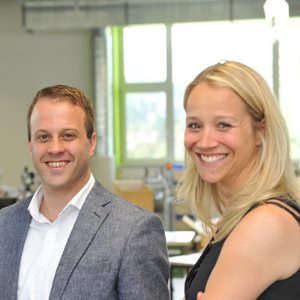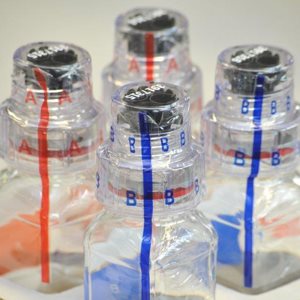A mistake could change a career: kits for doping samples must be clearly identifiable, relia-ble and protected against manipulation. Two LR Mate 200iC install the covers for this.
Identified: we’re talking about doping. But not about whether it is considered morally rep-rehensible or sanitary. But just about how the manufacture of anti-doping kits has been automated.
 Die Berlinger Special AG, Ganterschwil/CH, supplies associations and organisers worldwide with manipulation-secure kits, the so-called BEREG kits, for doping controls. Names of customers, even bulk purchasers are still treated more secretively than the figures of company profits. Anyhow, Berlinger is the world market leader for test kits. Export is at 98 %, the world market share is estimated to be 90 %. Courts across the world confirm the company’s reputation. Monika Egli, Senior Product Manager: “Our kit has always stood up in court.” This is known as watertight.
Die Berlinger Special AG, Ganterschwil/CH, supplies associations and organisers worldwide with manipulation-secure kits, the so-called BEREG kits, for doping controls. Names of customers, even bulk purchasers are still treated more secretively than the figures of company profits. Anyhow, Berlinger is the world market leader for test kits. Export is at 98 %, the world market share is estimated to be 90 %. Courts across the world confirm the company’s reputation. Monika Egli, Senior Product Manager: “Our kit has always stood up in court.” This is known as watertight.
Requirement figures, counterfeit protection and reliability were enough reason for Ber-linger to automate the installation of the cover made of several parts. Robofact AG is locat-ed in Gossau, just a few minutes from Ganterschwil: it is both active and successful as a system integrator in several sectors, especially in the medical-technical division. And Robofact actualised a system for automated installation at Berlinger.
Worthwhile automation
Is automation only worthwhile for high quantities? It is not about that, because in the mean-time almost three million covers have been assembled by the system. The kits are manually completed and made ready for dispatch. Manufacturing is according to order.
A kit always includes a container for a so-called A and B sample. Together with “Antidoping Schweiz”, Berlinger has developed the hardware for the test. These “safety containers” have been patented for Berlinger.
The covers consist of several parts, which are, in the meantime, assembled automated. The actual cover is put into the cell palette-wise. The stack on the inlet side, up to ten palettes high, is raised and the lower palettes in the cell are drawn. Because there are not just x2 but also x3 kits, there are always that many covers in cavities on the palette so that the number can be divided by two or three.
Seal rings and spring washers are added through the back of the cell by robots via two spiral conveyors. A part of the cover system, a metal spring washer, contests automation. Until now the investigated approaches for automation have either been technically un-workable or quite simply too expensive. Therefore, these metal spring washers are always placed manually on cushions in batches of 8 x 24 pieces, which are then placed by robots attainably in the cell.
The first work process in the cell is imprinting the security number. This number must be applied 100 % securely, whereby the first of the two robots, a FANUC LR Mate 200iC, is only the minion. Then the cover is completed in cooperation with a second LR Mate. An image processing system and several cameras support both of the FANUC robots.
 An important element within the cover is a raster ring. This ring has a pin on the external diameter, which must lie precisely in a nut of the cover and serve as a rotation lock. To this point it is a simple finger exercise for Robofact. The task is tricky because the upper and lower side of the ring are not the same
An important element within the cover is a raster ring. This ring has a pin on the external diameter, which must lie precisely in a nut of the cover and serve as a rotation lock. To this point it is a simple finger exercise for Robofact. The task is tricky because the upper and lower side of the ring are not the same
The mechanics of the spiral are conveyed in such a way that the ring is always positioned correctly and added in a user-friendly way for the robot. Image processing at this point serves only for the identification of the correct position of the ring. Originally the robot was going to grab the ring and position the ring for assembly with the wrist joint, there-fore the sixth axis. Fabian Anderegg, Food and Medical Division Manager for Robofact: “We have determined that we can achieve shorter cycle times with the current design.” A small amount of flexibility provision still remains.
However: in its sixth year of operation, the cycle time reserves have been relatively ex-ploited. Imprinting, ultrasonic welding and blowing with ionised air are processes that can-not be reduced with the given configuration. Thus the robotics’ movement is comparatively “comfortable”.